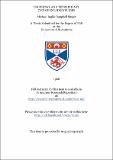Triphenyl- and tetraphenyl cyclopentadienylides
Abstract
The thermal decomposition of 2,3,4,5-tetraphenyldiazo cyclopentadiene in pyridine and methyl pyridines has been found to provide a route to the corresponding pyridinium 2,3,4,5-tetraphenyl-cyclopentadienylide. This procedure has been extended to include decomposition of the diazo compound in derivatives of Group V and VI elements and a route to a series of hitherto unreported tetraphenyloyclopentadienylides has been established. Triphenyl-phosphonium, triphenylarsonium, and triphenyIstibonium 2,3,4,5-tetraphenylcyclopentadienylides have been isolated as stable crystalline solids and evidence has been Sound for the existence of the triphenylbismuthonium analogue. Diphenylsulphoniumi methyIphenylsulphonium, and diphenylselenonium 2,3,4,5-tetra-phenyloyclopentadienylides have also been shown to have unusual stability. The mechanism of the decomposition reaction of 2,3,4,5- tetraphenyldiazocyclopentadiene is discussed and is considered to proceed by initial decomposition of the diazo compound to tetraphenyloarbenacyclopentadiene followed by eleotrophilic attack on a suitable heteror-atem group, containing a lone pair of electrons. A comparative study of the properties and the reactivities of the tetraphenylcyclopentadienylides with carbonyl compounds and nitrosobenzene has been made. The pKa's of some of the ylide conjugate acids were determined in 95% ethanol solution and it appears that for the similarly substituted ylidos there is no: consistent parallel between nucleophilicity and basicity. The thermal decomposition of other diazocyclopentadienes, including the 2,3,4,5-tetrachlora-, 2,3,4-tripheny1-1 5-bromo-2,3,4-triphenyl-, and 5-chloro-2,3,4-triphenyl- derivatives, occurred uncontrollably and attempts to obtain ylides failed when these diazo compounds were subjected to analogous conditions employed for 2,3,4,5-tetraphenyldiazocyclopentadiene. Phosphines were found to couple readily with substituted diazocyolopentadienes to form the corresponding phosphazines with the exception of the reaction between triphenylphosphine and 2,3,4,5-tetraphenyldiazocyclopentadiene. Evidence suggests that: these phosphazines, in acidic media, are protonated at the nitrogen atom rather than at the five-membered ring. Pyridinium 2,3,4-triphenyIcyclopentadienylide was prepared by alkylation of pyridine with 5-bromo-2,3,4-triphonyloyclo-pentadiene in a solution of nitromethane and subsequent basi-fication. In an attempt to prepare the analogous phosphomium ylide it was found that: triphonylphosphine in nitromethane led to reduction of the bromo compound. However when this reaction was carried out: in the absence of solventtriphenyl-(2,3,4-triphenyIcyclopentadienyl)phosphonium bromide was isolated. It has been found that tmiphenylarsine oxide and 2,3,4-triphenyloyclopentadiene undergo a reaction in triethylamine and phosphorus pentoxide to form triphenylarsonium 2,3,4- triphenyIeyclopentadienylide, and that' when the reaction is carried out in acetic anhydride the 5-acetyl ylide is formed. Some electrophilic substitution reactions on the triphenyl-phosphonium and triphenylarsonium 2,3,4-triphonyloyolopenta-dienylides have been done and the properties and nucleophilioity of these ylides have been investigated. A comparison has also been drawn between these ylides and their totmaphenylcyclopenta-dienylide analogues.
Type
Thesis, PhD Doctor of Philosophy
Collections
Items in the St Andrews Research Repository are protected by copyright, with all rights reserved, unless otherwise indicated.

